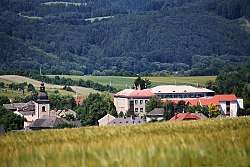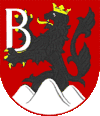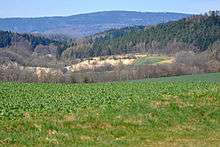Bludov (Šumperk District)
Bludov pronounced [bludof] (German: Blauda) (local dialect: Blodov) is a spa village in the Olomouc Region of the Czech Republic.
Bludov | |
|---|---|
Village | |
 | |
 Flag  Coat of arms | |
 Bludov Location in the Czech Republic | |
| Coordinates: 49°56′27″N 16°55′39″E | |
| Country | Czech Republic |
| Region | Olomouc |
| District | Šumperk |
| Municipality | Bludov (Šumperk District) |
| Founded | 13th century |
| Government | |
| • Mayor | Ing. Pavel Ston |
| Population (2 October 2008) | |
| • Total | 3,139 |
| Time zone | UTC+1 (CET) |
| • Summer (DST) | UTC+2 (CEST) |
| Postal code | 788 33 |
| Website | www |
Etymology
"Bludov" consists of two part.: The first part, "Blud", is a proper noun referring to the founder’s name. The second part, “-ov", is a suffix indicating location (e.g. a village or place). The English translation of "Bludov" would be "Blud Village" or "Blud Place". "Blauda" is an approximate German phonetic transcription.
History
Paměti obce Bludova
Paměti obce Bludova (Chronicle of the Bludov municipality) is an important source of the village's history. written by local historian Jan Březina. Essays dealing with Bludov before 1938 often use the chronicle as a reference, and a street in Bludov[1][2] is named for him.[3][4]
Bludov was established in the 13th century by Blud z Bludova, and was the only Czech village in the German Šumperk district. Blud z Bludova's son built the castle on the slope of the Háj hill.
During the 15th century Bludov became a possession of Tunkl z Brníčka, who built six large ponds near the village although his serfs rebelled during their construction. Tunkl was murdered, and his ponds abandoned. There is a local legend that the devil forces Tunkl's spirit to continue the construction himself.
Bludov Castle was destroyed during the Czech-Hungary Wars. During the 16th century Bludov became the possession of a Žerotín noble, who built a château. In 1929 a spa was opened, which has recently treated obesity. In 1963, the Vlčí důl (“Wolf Valley") pool was opened after it was built by volunteers. There are 3,139 residents of the town: 1,569 men and 1,545 women.
Economy

Economic history
Bludov was a farming village during the medieval and early modern eras. Local historian Jan Březina has speculated that gold was mined on Zlatník Hill ("Goldsmith Hill"), but there is little historical evidence for this claim. Panning may have been done in Vitonický potok (Vitonic Creek) at Vlčí Důl (Wolf Mine).
Six large ponds were created during the mid-15th century, none of which have been preserved. During the second half of the 19th century, Bludov was industrialized with the construction of two mills, a sawmill, two textile workshops, an engineering works and a limekiln. At the beginning of the 20th century, the textile factories failed and a dairy, an iron-foundry and a distillery were established. Lázně Bludov was opened in 1929.
Small and medium-sized businesses were suppressed by the communist government during the 1950s, and the spa and dairy were nationalized. During the 1970s the dairy was rebuilt as the Nealko, a soft-drink factory. The head office of the farm collective representing Bohutín, Chromeč, Sudkov, Nový Malín, and Temenice was built opposite a baroque chateau, with concrete functionalist architecture. Agrega, a factory repairing electric motors, was also established.
Nealko and Agrega faced financial troubles after the Velvet Revolution, prompting Agrega to expand its services to repair injection pumps, alternators, starters and cars and sell Peugot and Citroen cars and auto parts. Nealko produced an unsuccessful soft-drink brand, Monáda. It then produced soft drinks for diabetics before going bankrupt at the beginning of the 21st century.
Recent economy
Bludov's unemployment rate was 11.5 percent in 2012.[5] The village is near district economic centers, with public transportation to Šumperk.
In the Mohelnická Brázda lowlands, corn, barley, wheat, oilseed rape, poppy, sugar beet, alfalfa and flax are grown and cattle and broilers raised.[6] The Hanušovická vrchovina hills have a timber industry. Although the Nealko factory is now abandoned, the Agrega factory is still in operation.
The Granodiorite quarry is located on the Chocholík hill, where stone is processed into sand and a type of wollastonite known as Bludovit is sometimes mined. Bludovit is used decoratively, and its powder is used in blast furnaces.
There is a small hydroelectric plant at Habermannův mlýn (Habermann’s mill). The Bludov Spa focuses on obesity therapy, and there is a distillery in the village. Several small businesses engage in furniture, plumbing, carpentry, chimney sweeping and hardware.
See also
- Bludoveček and Zámeček
- Vlčí Důl
- Habermannův mlýn and Habermannova vila
- Bludov Castle
- Bludov Château
- Bludov Spa
- Zámek Bludov
References
- http://www.mapy.cz/#x=16.929335&y=49.943086&z=16
- http://www.mapy.cz/s/5rXY%5B%5D
- http://www.bludov.cz/O-Bludove/Vyznamni-rodaci-a-osobnosti-obce/Jan-Brezina.html Czech; An article at Bludov's official webpage
- http://www.infosumperk.cz/dr-cs/osobnosti-a-rodaci/sumpersko/brezina-jan-phdr.html%7Cthumbnail%7CCzech, Březina's name at a webpage of The Šumperk Local History Museum
- http://www.czso.cz/ Data z českého statistického úřadu
- http://www.bludovska.cz/?page=ziv CZ, list of production of the most significant farming company
External links
| Wikimedia Commons has media related to Bludov (Šumperk District). |
- Official website (in Czech)